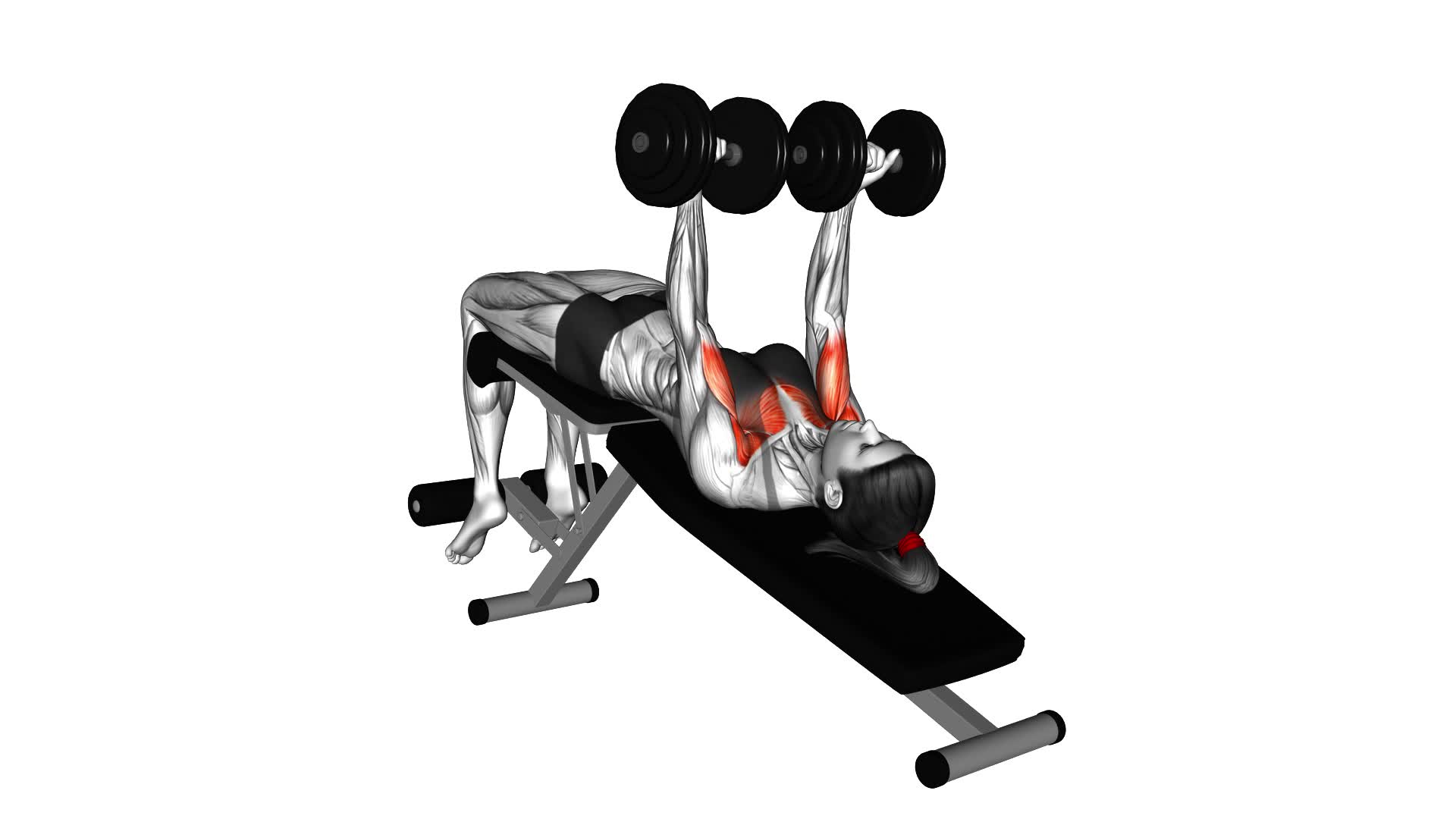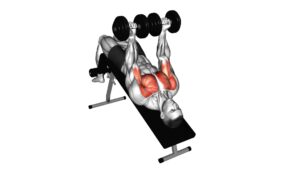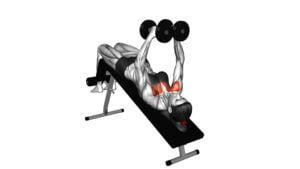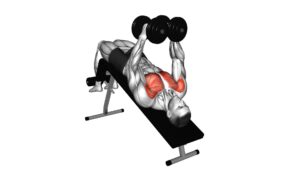Dumbbell Decline Twist Fly (female) – Video Exercise Guide & Tips

Are you looking for a challenging exercise to target your chest and shoulders? Look no further than the dumbbell decline twist fly.
Watch This Exercise Video
In this video exercise guide, we will show you how to perform this move with proper form and provide tips for maximizing its effectiveness.
Get ready to feel the burn and sculpt your upper body like never before.
Let's dive in and get started!
Key Takeaways
- The dumbbell decline twist fly targets multiple muscles in the upper body, including the pectoralis major and minor muscles, deltoids, rotator cuff muscles, and core muscles.
- It can be modified to target different areas of the chest and shoulders, and can be performed with dumbbells, a cable machine, or resistance bands.
- Proper technique is important, including using an appropriate weight, engaging the core, avoiding flaring the elbows, and focusing on the mind-muscle connection.
- Gradually increasing the weight and incorporating variations, such as performing the exercise on an unstable surface or adding a pause at the top of the movement, can increase intensity and challenge.
Benefits of the Dumbbell Decline Twist Fly
The dumbbell decline twist fly provides a range of benefits for you as you work out. This exercise targets multiple muscles in your upper body, making it a great addition to your routine.
One of the main advantages of the dumbbell decline twist fly is that it engages your chest muscles, particularly the pectoralis major and minor. These muscles are responsible for the horizontal adduction of your arms, which means they help bring your arms closer to the midline of your body.
Additionally, the dumbbell decline twist fly also activates your shoulder muscles, such as the deltoids and the rotator cuff muscles. These muscles play an essential role in stabilizing and controlling the movement of your shoulder joint.
By incorporating variations of the dumbbell decline twist fly into your workouts, you can target different areas of your chest and shoulders, ensuring a well-rounded upper body workout.
Now, let's move on to the equipment and setup for this exercise.
Equipment and Setup for the Exercise
To perform the dumbbell decline twist fly exercise, you'll need a set of dumbbells and an exercise bench. Here are the equipment and setup requirements for this exercise:
- Dumbbells: Choose a weight that challenges you but allows you to maintain proper form throughout the exercise. Start with a weight that you're comfortable with and gradually increase as you progress.
- Exercise Bench: Find a decline bench that's adjustable to various angles. Set the bench at a decline angle of around 30 to 45 degrees to target your chest muscles effectively.
Alternative exercises:
- Incline Dumbbell Fly: Perform the same exercise on an incline bench to target the upper chest muscles.
- Cable Fly: Use a cable machine instead of dumbbells to perform the fly motion. This variation provides constant tension throughout the movement.
- Push-ups: A bodyweight exercise that targets the chest muscles and can be modified to focus on different areas of the chest.
Variations on the exercise:
- Single-Arm Dumbbell Decline Twist Fly: Hold one dumbbell in each hand and perform the exercise one arm at a time.
- Resistance Band Decline Twist Fly: Attach resistance bands to the bench or a sturdy anchor point and perform the exercise using the bands for resistance.
Now that you know what equipment you need, let's move on to the step-by-step instructions for proper form.
Step-by-Step Instructions for Proper Form
To perform the dumbbell decline twist fly exercise with proper form, position yourself on the exercise bench at a decline angle of around 30 to 45 degrees. Lie down on the bench with your head at the lower end and secure your feet at the foot holders. Hold a dumbbell in each hand, with your palms facing each other and your arms extended straight up above your chest.
As you lower the dumbbells, keep a slight bend in your elbows and maintain control throughout the movement. Lower the dumbbells in a wide arc out to the sides of your body, while simultaneously twisting your wrists inward so that your palms face each other at the bottom of the movement. This twisting motion engages your chest muscles more effectively.
To return to the starting position, lift the dumbbells back up in the same wide arc, while twisting your wrists outward so that your palms face forward again. Keep your elbows slightly bent and avoid locking them out at the top of the movement.
Common misconceptions about this exercise include using too much weight, which can compromise form and lead to injury. It's important to start with lighter weights and gradually increase as you become comfortable with the movement.
Additionally, variations and modifications of this exercise can include using resistance bands instead of dumbbells, or performing the exercise on a stability ball to engage your core muscles.
Common Mistakes to Avoid
Avoid using excessive weight when performing the dumbbell decline twist fly exercise. Using too much weight can lead to improper form and increase the risk of injury. Stick to a weight that challenges you, but still allows you to maintain proper technique throughout the entire exercise.
To ensure you're performing the dumbbell decline twist fly correctly, here are some common mistakes to avoid:
- Not engaging your core: It's essential to engage your core muscles throughout the exercise to maintain stability and protect your lower back.
- Flaring your elbows: Keep your elbows slightly bent and close to your body throughout the movement. Avoid flaring them out to the sides, as this can strain your shoulders.
- Rushing the movement: Slow and controlled movements are key to reaping the benefits of this exercise. Avoid using momentum to swing the weights up and focus on the contraction of your chest muscles.
- Neglecting proper breathing: Don't hold your breath during the exercise. Inhale as you lower the dumbbells and exhale as you lift them, maintaining a steady breathing pattern.
Tips for Maximizing the Effectiveness of the Exercise
Maximize the effectiveness of your dumbbell decline twist fly exercise by incorporating these key tips.
To maximize results, it's important to focus on proper form and technique. First, ensure that you're using an appropriate weight for your fitness level. It should be challenging, but still allow you to maintain proper form throughout the exercise.
Engage your core muscles throughout the movement to increase stability and strengthen your abdominal muscles. As you perform the exercise, focus on squeezing your chest muscles at the top of the movement to fully engage them.
To add variation and challenge to the exercise, you can try different grip positions. Experiment with using an overhand grip, underhand grip, or a neutral grip to target different areas of the chest muscles.
Additionally, you can modify the exercise by adjusting the angle of the bench. Performing the dumbbell decline twist fly on a steeper decline will place more emphasis on the upper chest muscles, while a lesser decline will target the lower chest muscles.
Remember to always listen to your body and make modifications as needed. If you experience any discomfort or pain, stop the exercise and consult with a fitness professional.
Frequently Asked Questions
What Are the Alternative Exercises That Can Be Done Instead of the Dumbbell Decline Twist Fly?
If you're looking for alternative exercises for the dumbbell decline twist fly, there are a few options you can try.
One modification option is the cable crossover, which targets the chest muscles.
Another alternative is the dumbbell chest press, which focuses on the pectoral muscles.
Additionally, the push-up with a twist can also work similar muscles.
Remember to consult a fitness professional to ensure proper form and technique for these exercises.
How Many Repetitions and Sets Should I Do for the Dumbbell Decline Twist Fly?
To determine the number of repetitions and sets for the dumbbell decline twist fly, consider your fitness level and goals. Generally, aim for 8-12 reps and 2-4 sets.
Increasing intensity can be done by using heavier dumbbells or adding more sets.
Ensure proper form by keeping your core engaged, maintaining a controlled movement, and using a weight that challenges you without sacrificing technique.
Can Men Also Perform the Dumbbell Decline Twist Fly Exercise?
Yes, men can also perform the dumbbell decline twist fly exercise. It isn't limited to women only.
This exercise targets the chest muscles, specifically the pectoralis major and minor. By incorporating a decline position and a twisting motion, it engages the muscles in a unique way, helping to strengthen and tone them.
Adding this exercise to your routine can be beneficial for both men and women looking to enhance their chest muscles.
Are There Any Specific Breathing Techniques I Should Follow While Doing the Dumbbell Decline Twist Fly?
When doing the dumbbell decline twist fly, it's important to focus on your breathing techniques to ensure proper form.
Take a deep breath in before you start the exercise, and exhale as you twist and lower the dumbbells.
Inhale as you bring the dumbbells back up and twist to the other side.
Remember to keep your core engaged and maintain a steady breathing rhythm throughout the exercise for optimal results.
Can the Dumbbell Decline Twist Fly Help in Reducing Belly Fat?
The dumbbell decline twist fly can be a great addition to your workout routine if you're looking to reduce belly fat. By incorporating this exercise, you can target your abdominal muscles and engage your core.
To perform it properly, lie on a decline bench with a dumbbell in each hand. Start with your arms extended above your chest and then lower them out to the sides while twisting your torso. This movement helps to strengthen and tone your abs, contributing to a flatter stomach.
Conclusion
The dumbbell decline twist fly is a highly effective exercise for targeting the chest muscles. By adding a twist to the traditional fly movement, it engages the muscles in a unique way, promoting strength and definition.
To perform this exercise correctly, ensure proper form and avoid common mistakes such as using too much weight or arching the back.
By following these tips and maximizing the effectiveness of the exercise, you can achieve great results in your chest workouts.

Author
Years ago, the spark of my life’s passion ignited in my mind the moment I stepped into the local gym for the first time. The inaugural bead of perspiration, the initial endeavor, the very first surge of endorphins, and a sense of pride that washed over me post-workout marked the beginning of my deep-seated interest in strength sports, fitness, and sports nutrition. This very curiosity blossomed rapidly into a profound fascination, propelling me to earn a Master’s degree in Physical Education from the Academy of Physical Education in Krakow, followed by a Sports Manager diploma from the Jagiellonian University. My journey of growth led me to gain more specialized qualifications, such as being a certified personal trainer with a focus on sports dietetics, a lifeguard, and an instructor for wellness and corrective gymnastics. Theoretical knowledge paired seamlessly with practical experience, reinforcing my belief that the transformation of individuals under my guidance was also a reflection of my personal growth. This belief holds true even today. Each day, I strive to push the boundaries and explore new realms. These realms gently elevate me to greater heights. The unique combination of passion for my field and the continuous quest for growth fuels my drive to break new ground.







